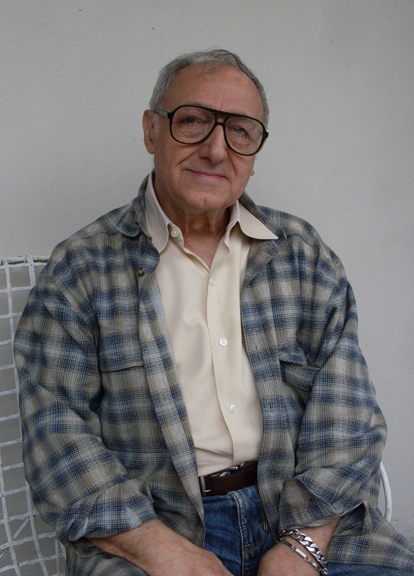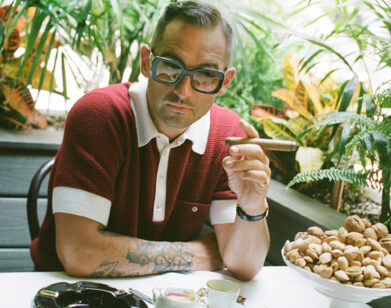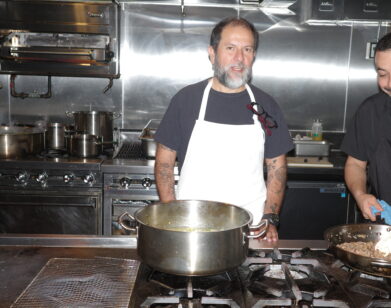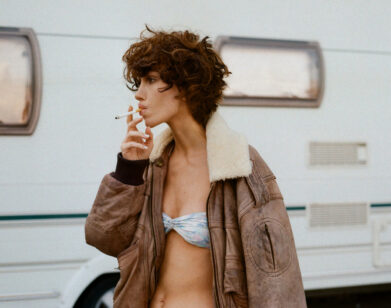Illustrating Andy: Vito Giallo on Warhol’s New York

VITO GIALLO. PHOTO COURTESY OF THOMAS KIEDROWSKI
Each new generation of New Yorkers hungers to shape the city. Andy Warhol’s New York City: Four Walks Uptown to Downtown (The Little Bookroom) reveals how Warhol did just that; the book provides walking directions and information about some of the most important landmarks in his life. Accompanying text by Warhol expert Thomas Kiedrowski provides intimate insight into these places: from the house where he lived with his mother, to the Factory where he was shot; from Edie Sedgwick’s old building to New York staples like Bloomingdale’s and the Whitney. Warhol’s first paid studio assistant and fellow illustrator Vito Giallo adds his beautiful drawings to original photos of Warhol through all stages of his life and all over the city he made his home and inspiration. We talked with Giallo about when he met Warhol, how fame changes people, what he misses most about old New York, and what about the city inspired Warhol and so many artists after him.
ROYAL YOUNG: How did you first meet Andy?
VITO GIALLO: In 1953, 1954, I formed an art gallery called The Loft Gallery and I selected him as one of the exhibitors. And gave him, really, his first one-man show in 1954.
YOUNG: How had you found out about his work?
GIALLO: I was a commercial artist at the time, and Andy was one of the most famous commercial artists of his time. Everyone knew his work, and I admired it.
YOUNG: Were you born in New York, Vito?
GIALLO: I was born in Brewster, New York. I came to the city in 1949 to go to art school. I think Andy came about the same time, but we didn’t meet till 1954.
YOUNG: And you’re still in New York?
GIALLO: Yes, I live in Brooklyn.
YOUNG: What are the most drastic changes you’ve seen in New York in the time you’ve lived here?
GIALLO: The elimination of illustrators and most of the print world. Photography has taken its place. That was a major change, because when I was going to school and in the work world, illustrators were very important. Fashion illustrators like Dorothy Hood, now you don’t see that.
YOUNG: What do you miss the most about old New York?
GIALLO: I miss the amount of interesting shops on Third Avenue, I miss the Third Avenue El, and of course the rents were all very cheap at that time. It was just a different world. You didn’t dare walk in blue jeans on Fifth Avenue.
YOUNG: What happened if you did?
GIALLO: People would look at you and make you feel embarrassed about it. People were more dressed up, even Andy. We all wore chinos and loafers with white socks. Nobody wore worn clothing.
YOUNG: When did that change?
GIALLO: Probably the ’60s.
YOUNG: What’s the wildest night you’ve had out on the town in New York?
GIALLO: I was never a party person, so even though Andy and I went to many parties, it was very low-key. It was nothing like his later life. I don’t think I’ve ever been to a wild party.
YOUNG: So when did you see Andy’s transition from a no-party guy to his later life? Was it when he became more famous?
GIALLO: Yes, I think the more he became famous, the more he dropped people who weren’t famous. I could see that in him. It was very important for him to be with famous people. If not famous, they had to be very rich. He was always extremely impressed by them if they were wealthy. We had a falling-out, from I think 1957 to when I was on Madison Avenue and I had my antique shop—and then he was so impressed. He thought I had arrived.
YOUNG: What was your interest in antiques?
GIALLO: I was always interested in antiques. When I stopped working for Andy, I opened my own shop. The best part of that is that I was antique dealer to many of the artists who were of the New York abstract impressionist school. Especially Mark Rothko.
YOUNG: How do you think New York City influenced Warhol’s work?
GIALLO: Mostly the people, the society, the social scene. I think that more than anything else.
YOUNG: Who do you mean when you say “the people”?
GIALLO: Well, there are so many celebrities here, so many socialites, so many parties and events and upscale restaurants. He loved all that.
YOUNG: Why do you think that is? What was the attraction?
GIALLO: Well I think the attraction is, he was brought up so poor. And when all this happened to him, he was just overwhelmed.
YOUNG: Yeah. Do you feel like you were overwhelmed by that world? It doesn’t seem so.
GIALLO: No, not really.
YOUNG: Why was that?
GIALLO: I wasn’t impressed as much as Andy. When he was in my shop, somebody would come in, and before they got in, if he happened to know them, he would always say, “Oh, she’s so rich!” [laughs]
YOUNG: And how do you feel New York City has influenced you in your work, in your life, in your love of antiques, in your illustration?
GIALLO: This city is so vibrant and so alive. I get excited by all of that. The art world comes alive here.
YOUNG: Could you ever imagine leaving?
GIALLO: No, I don’t think I ever would.
ANDY WARHOL’S NEW YORK CITY: FOUR WALKS, UPTOWN TO DOWNTOWN WILL BE AVAILABLE JULY 12. FOR MORE ON THE BOOK, CLICK HERE. A LAUNCH PARTY WITH VITO GIALLO AND THOMAS KIEDROWSKI, FREE AND OPEN TO THE PUBLIC, WILL BE HELD AT CLIC GALLERY ON JULY 13. FOR MORE INFORMATION, CLICK HERE.






